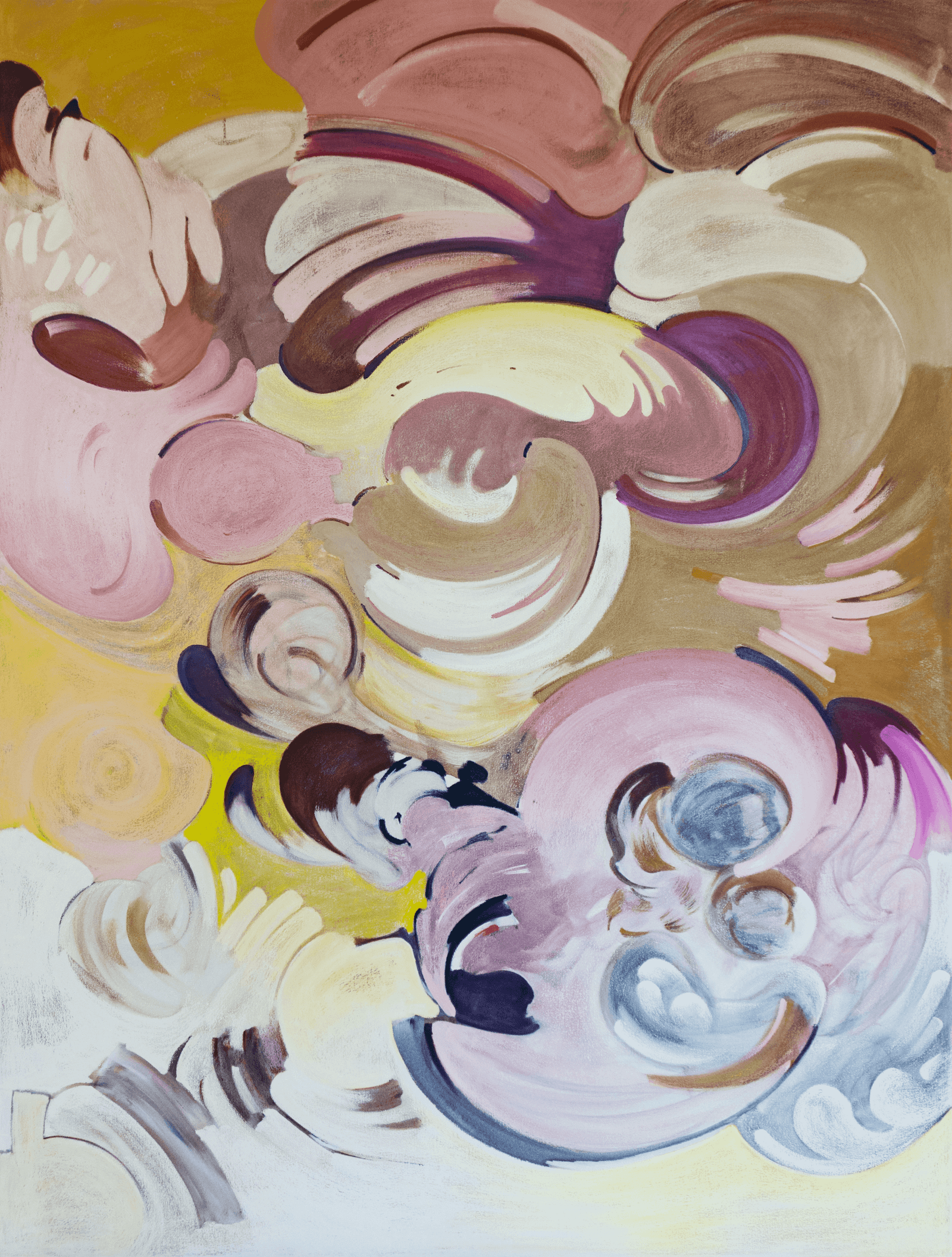Kaifan Wang
Is the spot on the neck bitten
by mosquitoes?
➝ Download Press Release
The young artist Kaifan Wang presents his first solo exhibition in Belgium at GNYP Gallery’s new venue in Antwerp. He created many of the works during a residency in the atelier above the gallery space. His canvases are larger than ever. Operating within the medium that he masters, he consciously challenges the relationship between his body and the canvas. He has to jump up to reach the upper parts of the canvas: he flirts with the limits of what is reachable for his body. In this way, a small degree of chance enters the work, but above all an energetic movement.
Kaifan Wang applies the paint for his abstract undulating forms with sponges and oil pastels. During the Corona crisis, he saw many students from the Chinese community in Berlin, where Wang lives and works, move back home. They left some of their belongings behind, among them their mattresses. He took them over, cut them open and turned them into painting tools so the mattress fabric evolved into sponges. The mattresses have remained present also in another way: in sculptural installations that engage in a dialogue with the paintings.
Because the mattresses have been used, they carry the traces of people; visible, as a possible imprint of the body, and invisible in DNA residues. They are carriers of intimacy, of things that happen at home. That suggestion of sensuality also resides in the questioning title of the exhibition: Is the spot on the neck bitten by mosquitoes? What if that spot is not a mosquito bite, but a hickey? That abstract, vague spot could also be a sign of a very intimate relationship between human bodies.
However, the title also implies an inside-outside relationship in case it does refer to a mosquito bite: organisms from outside can cause an allergic reaction and thus have an impact on our skin. Also the mattresses signal an externality in this particular constellation - living between different communities and cultures. Kaifan Wang makes this duality between inside and outside explicit by stripping the mattresses and only showing the bed springs. The inherent tension and movement in the springs is reflected in the dynamics of the paintings.
The way the paint has been applied to his canvases, layered in different materials and textures, hints at Wang’s art historical inspiration sources; it is not only reminiscent of how medieval frescoes were constructed, but also how they are now being recovered in layers. Seeing through the damage of centuries of exposure to weather conditions and deterioration by human action (via touch or even just breathing), remaining fragments of the original paintings are visible and consequently, the wall unites several pasts in the present.
In his still young oeuvre, Wang has made a transition from more autobiographical work to the painting that is universally abstract, with a great openness to the viewer’s interpretation. More than before, his art of painting unfolds on the fluid, transparent boundary between an individual human body and nature, exposing the limitations and complexity of both. Titles such as Vibrating Air, I Sneezed on the Grass, Whispers in Soot, and Restless Meadow refer to the relationship between body and nature, but they also have an important unifying factor: the wind.
Wind is a force of nature and a carrier of variety of ephemera: from words to sighs, from sounds to smells and of our breathing. Wind can also cause devastation. Even in all its apparent softness, it can make things difficult for humans, as a transmitter of pollen, insects, disease and infection. Indeed, Hippocrates writes that the west wind can make people sick, while according to Voltaire, the east wind drives people to somberness and even suicide. In the myth of Eros and Psyche, Zephyrus, the west wind that is a harbinger of spring, is the one who transports Psyche to the enchanted castle of Eros, uniting the lovers. In another myth, both Apollo and Zephyrus fall in love with the young mortal Hyacinthus, but Hyacinthus is more attracted to Apollo. In a furious fit of jealousy, Zephyrus causes a discus to suddenly change direction, and is thus responsible for Hyacinthus’ death. The wind can be gentle and loving, but it can also be harsh, erratic and deadly.
Throughout art history, wind has been rendered in a huge variety of ways, from blowing personifications with bulging cheeks in the Renaissance to single dashes or curls in the air in pop art. Kaifan Wang does not represent wind as such but fills his paintings with a similar openness and inspiration. Wind touches our mental and physical state of being through the skin and breathing. Perhaps these undulating abstract forms also give us goosebumps. They are immersive and fickle like the wind itself: they carry the vagueness of memory, the fragile energy of a breath and the determined force of a storm.
Tamara Beheydt

Additional Information
Kaifan Wang X YENTSÉ
GNYP is beyond proud to present the two exceptional talents Kaifan Wang and Yentsé together at our Antwerp location starting August 26th until September 24th. Complementary to the exhibition ‘Is the spot on the neck bitten by mosquitoes?’ by Kaifan Wang we will showcase an installation by the Antwerp-based, China-born fashion designer Jin Yentsé.
